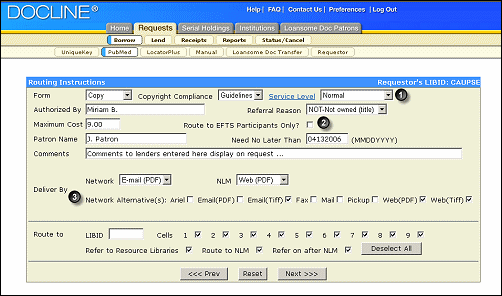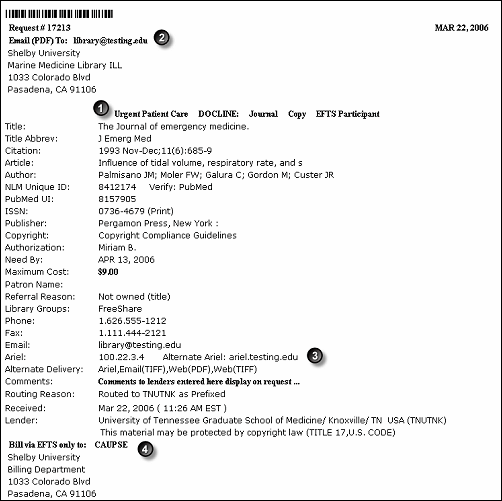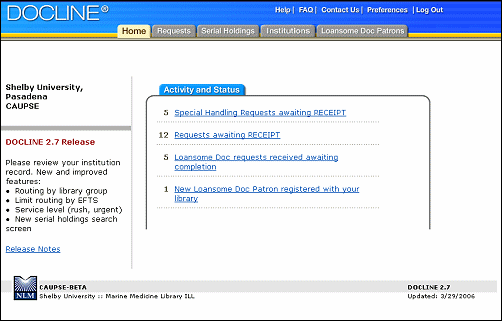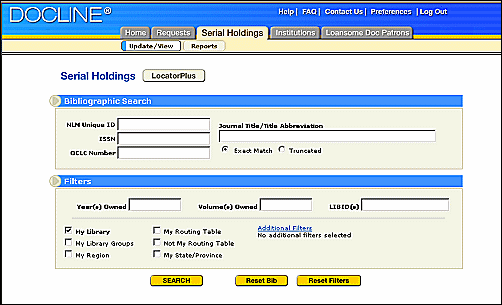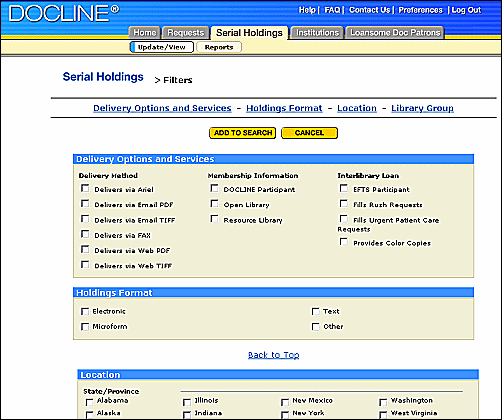DOCLINE® 2.7: The Next Generation of Routing
o n March 29, 2006, the U.S. National Library of Medicine® released DOCLINE 2.7. DOCLINE is an automated interlibrary loan request and routing system. DOCLINE provides health science libraries in the National Network of Libraries of Medicine (NN/LM), Canada, Mexico, and select international libraries with means to request biomedical literature.
The new version of DOCLINE contains key enhancements requested by DOCLINE users. DOCLINE 2.7 introduces routing by library group, requesting by service level (rush and urgent patient care), limiting routing to Electronic Fund Transfer System (EFTS) participants, routing by multiple delivery methods, searching serial holdings by delivery method, and a new appearance and functionality for serial holdings searching.
Borrowing
DOCLINE 2.7 adds several major enhancements to the request (borrowing) functionality. The most significant change is the ability to route requests by a Library Group as well as to individual libraries.
Prior to DOCLINE 2.7, borrowers were limited to listing 180 libraries as potential lenders for their requests, grouped in a hierarchy of nine Routing Table cells. Routing by Library Group widens the available pool of libraries to which a request may route by allowing a Library Group to be added to a Routing Table cell. Membership in the various Library Groups ranges from eleven libraries to more than 1,000 libraries. During routing, DOCLINE will randomly select up to a maximum of 20 libraries per Routing Table cell to which requests will route - libraries that report owning the title volume or year and that also match the other routing instructions. With DOCLINE's intelligent routing, a request typically does not need to route to more libraries to be filled, but a request may need more libraries to which it has the possibility to route.
DOCLINE 2.7 also adds libraries in the NN/LM level of "Other" to the end of the routing algorithm. "Other" libraries consist primarily of special libraries, associations, and Canadian libraries. The Routing by Library Group feature and the addition of "Other" libraries to the routing make it possible for borrowers to include every DOCLINE library as a potential lender for a request, thereby utilizing the full resources of the NN/LM and DOCLINE. For a full description of DOCLINE's routing algorithm, see the FAQ at: //www.nlm.nih.gov/services/doc_new_routing.html.
When placing a request, the borrower's default ordering preferences are displayed. A borrower can modify the default values on a request-by-request basis depending upon the needs of the patron. DOCLINE 2.7 added service levels to the request module (see Figure 1, item 1). The service levels of Normal, Rush, and Urgent Patient Care indicate the urgency of the borrower and carry with it different rules in DOCLINE. For example, a request can be placed with the level "Urgent Patient Care," indicating that it is needed for immediate clinical care of a patient. These requests should be processed immediately by the lender, and with electronic delivery, could be received by the borrower within hours of placing the request. If not acted upon by the lender, the request reroutes to another library after one (1) day, rather than the three (3) days for a normal interlibrary loan (ILL) request.
With DOCLINE 2.7, borrowers now have the option of limiting the routing of their requests to participants of the EFTS (see Figure 1, item 2). EFTS is a transaction-based electronic billing system developed by the University of Connecticut Health Center for ILL and document delivery charges. This option allows borrowers and lenders to reduce cost and paperwork associated with paper invoices.
DOCLINE 2.7 also adds the ability to specify multiple delivery methods (see Figure 1, item 3). This enhancement takes advantage of the growing use of electronic delivery. The ability to specify one or more acceptable alternate delivery methods adds greater flexibility and control over routing for borrowers. Libraries continue to indicate a single preferred delivery method for Network libraries, as well as a distinct NLM delivery method.
During routing of a request, cell by cell, DOCLINE will route first to libraries that hold the year or volume of the title requested and that support a borrower's preferred delivery method, and then route to libraries that support one of the borrower's alternate delivery method(s). For example, if a borrower's preferred network delivery method is Web PDF and the alternate delivery methods are Email PDF and Ariel, the algorithm would first route to libraries in cell 1 that deliver via Web PDF, and then try to route to libraries in cell 1 that support Email PDF OR deliver via Ariel. If the request had to route on to cell 2, it would first route to libraries in cell 2 that deliver via Web PDF, and then try to route to libraries in cell 2 that deliver via Email PDF OR deliver via Ariel, and so on.
New features for the request "receipt" include the addition of service level (see Figure 2, item 1) in the request header. The primary "Ship to" address continues to display at the top of the page (see Figure 2, item 2) while DOCLINE 2.7 added the alternate delivery methods in the body of the receipt (see Figure 2, item 3). When the borrower restricts routing to EFTS participants, the request receipt alerts lenders to the billing method in the "Bill to" area (see Figure 2, item 4).
DOCLINE displays a summary of a library's current request activity on the homepage (see Figure 3). It also lists requests to the library as a lender awaiting receipt or awaiting action, and warns the library of requests which will be automatically rerouted on to another library unless acted upon that day. Rush and Urgent Patient Care requests as well as color copy requests are indicated separately on the homepage as "Special Handling" requests to identify to libraries those items needing expedited or special handling.
Serial Holdings
DOCLINE 2.7 provides a new appearance and enhanced functionality to the search interface to the serial holdings records in DOCLINE. The search interface is available to libraries primarily for the updating of their holdings data. However, libraries can also search the holdings of other member libraries by serial title. For the efficient routing of requests, libraries must maintain accurate serial holdings and institution records so that the routing algorithm has current holdings data and ILL service information to act upon.
The Serial Holdings Add/Update and View search screens have been combined into one search interface - Update/View (see Figure 4). User permissions to view or update Serial Holdings remain unchanged. Users with view only permissions will now search Serial Holdings via the same interface as those who have edit permissions. User permissions for DOCLINE are maintained by the Regional Medical Libraries and the Canada Institute for Scientific and Technical Information (CISTI).
The Bibliographic Search has been revised to provide a more appealing interface with quick access to commonly used search features. Search filters have changed so that the most popular filters are easily accessible on the initial Serial Holdings Update/View screen. Year(s) Owned, Volume(s) Owned, and LIBIDs filters are displayed first, followed by the Top Filters of My Library, My Library Groups, My Region, My Routing Table, Not My Routing Table, and My State/Province.
Libraries can further limit their search results by clicking on the Additional Filters link. Additional filters include Delivery Methods, Membership information, Interlibrary Loan services, State/Province, Region, and Library Groups (see Figure 5).
Collins M. DOCLINE® 2.7: The Next Generation of Routing. NLM Tech Bull. 2006 Mar-Apr;(349):e8.

